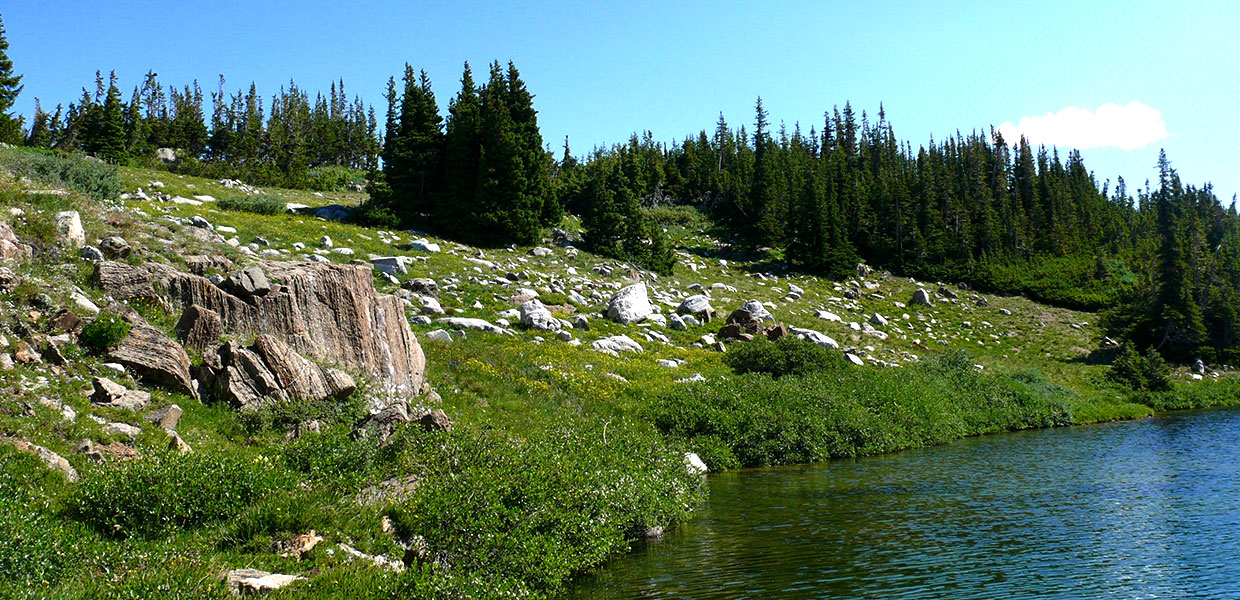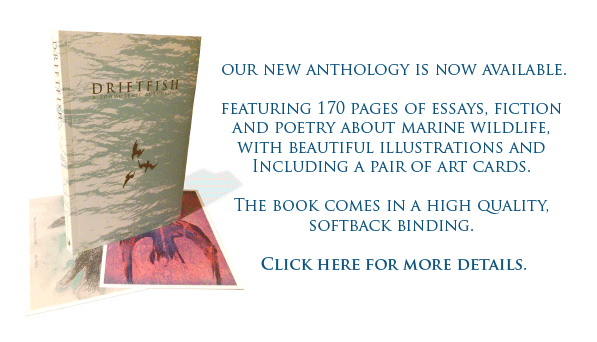by Anja Semanco
Let us think about life at the beginning. Not the false beginning in which we picture some kind of wicked finned fish or terrible trilobite rolling around in the primeval waves of ancient oceans. Not the Devonian period in which we consider the brachiopods and ammonites, the slinking swimmers pushing their way through a burgeoning ocean. No, let us think back further. Only a slim billion years after the earth’s formation, as it hurled through the universe like a pebble of rain in a fierce storm. Just moments after the surface finally firmed a semi-stable crust on which life could begin to take hold.
Imagine then an ocean, stretching down to inky black depths, and filled with a profound emptiness. Barely more than water filling rock, like a great sterile cup holding the potential for eternity. The expansive water world replete with nothing more than the lifeless stones and minerals that have pieced this new creation together. The only deep-sea movement arising from magmatic ocean vents, sending roiling flumes of shimmering, searing water bursting from the ocean floor. Rising through the curls of ocean currents as a ritual. And not a creature paddles through the soup to notice.
Float back now to the surface and follow the hull of this primordial ocean, in all its vastness to a clear, warm continental shelf, where the ecotone of empty rock and empty sea meet. This gently sloping mantle of tepid sea water, filled with piercing sun is where it all begins. It starts where everything starts, on the bottom of the ocean.
Here, the sea is not so empty. Here, rising from the shallow bottom like Grecian pillars, stand the slimy mounds of stromatolites. Wadded into gummy black and green piles that hold firm in the shallow pools as sentinels, watching for the molecules of creation to begin. Geologists believe they are earth’s first life form. And although the stromatolites do not know it, they will serve as the assembled platform, the great heaving crust that will eventually breathe all life into the world.
These columnar mounds of archea and cyanobacteria are weaved together in perfect fibrous stoicism on the new earth, in the shallow shelf of the new ocean. As nothing greater than a collection of single celled organisms, they are stitching together the fabric that will support multicellular life.
By day, the photosynthetic cyanobacteria take in the sunlight, while producing a layer of sticky mucus. As the sediment of this early sea settles over them, they migrate upward, forever upward, toward the sun, leaving behind a mound of calcium carbonate and other minerals they no longer require. Tumbled upward and forming a spongy scalp, they accept new light into their wriggling single-celled bodies.
One expelled puff at a time, these simple bacteria let out a breath of oxygen, like the plants we know today. A super organism hauling the breath of life into an atmosphere filled with carbon dioxide. Each exhalation brings the prehistoric world one step closer to cells with a nucleus, cells that gather together to create skin, and gills, and eyes. An insufflation that eventually leads to a nervous system, a brain. To us.
And it all starts here, beneath the waves, in what has long been referred to as the primordial soup, where these simple creatures know nothing more than the ocean waves and themselves. And over time, over the next few billion years, they continue this slow gentle breathing, until the atmosphere begins to take on a different tone. Suddenly an infantile world awakens one morning to find itself filled with a gas unlike any it has ever known. Oxygen. The DNA floating freely in the liquid bacterial bodies notice too. And so they modulate. A helical double twist churns, turning one base pair to another, mutating one letter here and there, until something inconceivable begins.
Life diversifies, accumulates, multiplies, until the liquid oceans are teeming with it. So much so that they burst forth onto land and overflow over the rocks, rocks that for so long knew nothing more than the wind and the rain. And here they are now, feeling the claws and scales and scuttles of this new life wordlessly plowing onto their shores.
The incredible unraveling mystery begins. And so we can look back to our early oceans as a space where the dregs of life accumulated into a deeply textured biota, and know that this is what we are made of. Our blood is saline, we are pumped full of the early oceans. Our cells turn over the molecular oxygen, this universal currency produced by our photosynthetic hosts billions of years ago in the salty shallows. Some of us still regard it as sacred.
Some of us still stand along the coastlines while the stuff of life washes over the pink soles of our feet and we know that it is all one thing. The tenderness of a milky warm tidal pool, the rapture of gale ripping over the shore, it is all intertwined like rope and we are clinging to it for dear life.
And still the stromatolites breathe on. Changing little over a few billion years, but nothing beyond their wrinkled microbial mats stretching up to the sky. They are still recognizable off the coasts of Australia and Mexico today. And still they breathe and breathe and breathe, letting their oxygen bubble up in the sloshing waves, standing in as living fossils, showing the world as it might have been back at the beginning.
The beginning is what I’m searching for. At the top of a mountain in the Snowy Range in Wyoming, I am looking for that baptismal creature, the invigorating confrontation of what is left from the rush of early life. These mountaintops were once the sea level beaches and shallow ocean shelves, clustered with marine life. But geology is a swift river, scarcely waiting a single second before shifting, adjusting to new intricacies. And all of a sudden, wham, the ocean floor is solidified and sitting atop a mountain, and the stromatolites glued like cement to that floor are 12,000 feet up in the air, mineralized, preserved as altars to the past.
The little fragile bodies of the bacteria are of course long gone, but the mounds of sediment they left behind fill with minerals and remain. The act of fossilization operates much like a treasure map, leaving behind just enough bits and clues that you can begin to piece together what might be truth, but equally could be wild postulation that later collapses under the weight of new information. And then, of course, there is also what we don’t see, that which is buried beneath the Earth’s surface. If you are like me, I suspect that you might find this interesting, this idea that what is below the surface could be remnants of ancient life that have been quietly thriving for an incredible length of time.
The ocean erases, but it also preserves and I am seeking the lone survivors that travelled all this way for all this time. The impulse to see the old world is inexplicable and I am overwhelmed by the thought of these husks of life perched on the mountaintop like fierce gargoyles. I know few who are immune to the thoughts of the light and wild wandering of the cosmos. And these oceanic fossils bring me there, bring me back to the beginning of it all.
I am weightless as I hurry over the dirt trails and past glacial lakes. There is a sense of urgency looming over me, that I might miss it. That somehow these fossils will pick up and dissolve just before I crest the final lip of the mountain. I know right where they are. I was here three years ago on a field study and my feet pass over the rocks like fingers over braille. It is all familiar.
I crash through bushes and tree branches along the banks of a glassy glacial pool, and there in the distance, at the far end of the lake, I see it like a cliff, jutting into the water. From here, from the edge of the trail, it might be nothing more than glacial till, a remnant of the mountains past. But I can see its circular brim, the laminations streaking it, waving to me in incomprehensible gestures.
I descend, through alpine buttercups, sunflowers and lupine. Down the bank, and then it begins. The rocks suddenly change and I notice the wave-like striations, folded into one another. Melting together in a pillowy cluster, these are the footprints of creation. The hillside is strewn with bits of stromatolites. But I am racing towards the largest one, the ‘big daddy,’ resting in the water much like it would have done during its biotic years.
I tumble down the alpine grass and come to rest on the stromatolite’s surface. Lying down with my belly against it, I don’t even come close to stretching all the way across. I trace my fingers through the valleys and ridges and if I close my eyes I can hear the ocean waves from billions of years ago. I am lying on our origination. I am lying on the beginning of time. So much of who we are began right here, in this collection of preserved ocean life.
It is here in this glacial lake, lying on this ancient life that I am reminded just how new we humans are. We are soft lanugo on the head of a baby while the earth grumbles as an old man below us. My hand dips into the chilly lake and I imagine an ocean lapping against my fingertips. I can taste salt in my mouth.
I sit like that on the edge of the stromatolite for a long time, letting the cool water run over my hands. We are born from the mesmerizing ocean, with the power to create or destroy in the same swift wave. This is the very stuff of life. This is our inheritance.
And as our inheritance we must recognize that just as the cyanobacteria of stromatolites changed the atmosphere drastically, so we too are changing our atmosphere in extreme ways. Rachel Carson pondered this sentiment as well in her famous book, The Sea Around Us.
“It is a curious situation that the sea, from which life first arose, should now be threatened by the activities of one form of that life. But the sea, though changed in a sinister way, will continue to exist; the threat is rather to life itself.”
We must believe that if a tiny speck of bacteria can alter the course of the earth, then we can do significantly worse. Carson was referring to the testing of nuclear weapons and dumping of nuclear waste in the 1950s. But now we must look to the carbon dioxide we emit. We must look to the acidification of our mother oceans, our earthly wombs. We must watch shelled creatures dissolve before our eyes, and coral turn white as cotton, while we continue to emit, emit, emit.
Carson’s words hold true more than 60 years later, that regardless of when and how life crumples, the oceans will always be there. And perhaps those oceans, after sitting in perfect silence for billions of years when all other life has been obliterated, will begin the living world again as mounds in a shallow sea. A blob of bacteria gathering to create something new.
We are just one more life form jetting our waste into the world. The difference is that we are cursed by the knowledge of our actions and therefore cursed by responsibility.
The sea is our creation story. The sea is our mythology. We arose from it just as mysteriously as any other miracle.
We can look to stromatolites as the irrevocable truth that no matter how small the life, no matter how seemingly insignificant, as a collection, any organism can change the world. As a collection, we are changing the world in one way, but I believe as a collection we can also change it back.
Like the tides, we flow, but we can also ebb. We can pull back our impact.
Geology speaks in time and through our need for consumption, production, progress, we humans are speaking over it. We are yelling louder than geology by speeding up processes that take thousands and millions of years. We are yelling over geology, we are yelling over nature, and we are yelling over ourselves. We are hoarse with all there is to say.
The oceans hear us. They are harboring our toddler like tantrums in the form of depleted fisheries, ocean acidification, miles of slick spilled oil. Yet they are silent. Or so we believe they’re silent. We never stop shouting long enough to listen.
I thought all these thoughts as I lay belly to stromatolite, breathing my own breath of life. The glacial lake became a silent, waveless ocean. The glacial lake was a stilled mind. I was back at the beginning but I was also at the end. From rise to fall it all cycles through whether we want it to or not. We have the choice to show up for it, or wait crouched in the water with our eyes shut tight.
There is something primordial about the silence. I watch the little fishes peak out from beneath the fossil and wondered how much more it knew than I, if only I could hear it.
We are on the cusp of the beginning. We are on the cusp of the end. We are standing on the edge of the oceanic shelf, peering out over what is held below in black water. We cannot know what it contains. We are stromatolites piling up. If we listen, we might hear the depths calling to us, telling us something new.
The sea is our mother, our womb. I leave the stromatolite believing we are kin.
Rachel Carson said, “Eventually man, too, found his way back to the sea. Standing on its shores, he must have looked out upon it with wonder and curiosity, compounded with an unconscious recognition of his lineage.”
Anja Semanco is a Boulder, Colorado based writer. Her graduate student work at the University of Colorado Boulder focuses on environmental journalism and the importance of natural history. Her nonfiction has been nominated for a Pushcart Prize and appears in Terrain.org. Keep up with her at anjasemanco.wordpress.com


